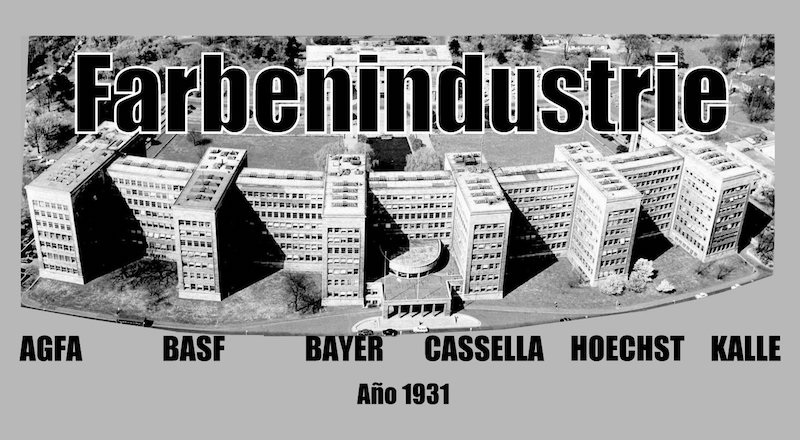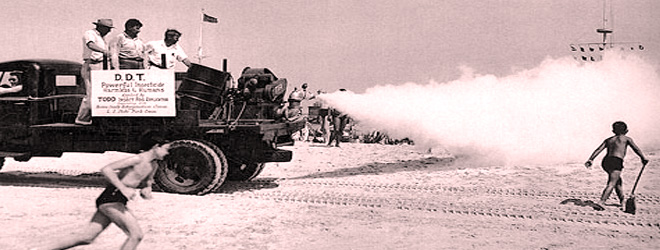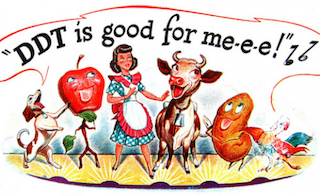Pesticide-use and the control of pest populations with synthetic chemicals are a subset of the history of the “modernization” of agricultural practices. This narrative positions pesticides as an antidote to the food supply problem of the growing world population, but it remains eerily silent on the assault on the entire ecosystem that the continuous use of chemicals entails. These moments of silence in history act as heuristic devices that crystallize aspects of historical production that best expose when and where power gets into the story (Trouillot and Carby, 2015, p.15). The dominant narratives and silences around the question of pesticide exposure point towards the locus of power in the story of the development of modern agriculture.
From ‘Pest-Management’ to the ‘War against Insects’
Today, a mind-boggling variety of chemical molecules, around 1400 pesticides, are used in agriculture globally. The proliferation of chemicals for crop protection is associated with the emergence of organized agriculture and pest control is mentioned in texts dating back to Homer. However, the modern industrial-agricultural paradigm marks a stark shift in the way it views pests as a threat to human survival. This idea is central to the battle of control over natural resources, which mandates pesticides as essential tools for ensuring food security, public health, and overall high standards of living.
The rise of the Chemical Industry in the Early Twentieth Century
The first German chemical company often referred to as “Baby Farben” was formed in the year 1904. After the end of the First World War, it was consolidated into I. G. Farben—the German chemical cartel—with the coming together of Bayer, BASF, and Hoechst. Concomitantly, another chemical cartel was formed in Switzerland, which included the chemical giant Basle A. G corporation, along with other chemical manufacturers like Ciba, Geigy, and Sandoz.

The IG Farben Cartel in Germany. Source: Alliance for Human Research Protection
The increased supply of chemical pesticides as a result of these developments translated into the application of huge amounts of arsenic compounds on food and cotton in the late 1920s. In 1931, a scientist working for the American conglomerate DuPont discovered the pesticidal properties of a class of compounds called “carbamates.” Following this in 1932, the first use of an organophosphate as a pesticide took place. A few years later in 1936, Methyl bromide was introduced to the United States by the California Department of Food and Agriculture.
DDT: The cure for all maladies
Although these developments seem incremental, the year 1939 can be said to be truly a watershed moment in the history of agrochemicals, embedded in the context of World War II. First synthesized by a German chemist in 1874, the properties of DDT (dichloro-diphenyl-trichloro-ethane) as an insecticide were discovered only in 1939 by a Swiss entomologist Paul Muller, working for Geigy Chemicals. DDT became popular as a suitable method for eradicating insect-borne disease among farmers almost instantly. The chemical industry came to be known as a “child of the second world war” and rightly so. In the course of developing agents of chemical warfare, some of the chemicals created in the lab were found to be lethal to insects—some of them became deadly nerve gases [and] others, of closely allied structure, became insecticides” (Shiva, 2016, p.110). The entry of the United States in World War II against Germany and Japan spurred an urgent need to increase production and feed war-torn Europe. As a result, agriculture in the United States became even more industrialized, using chemicals, mechanization, and monoculture.

A war tank spraying DDT. Source: Pesticide Action Network- North America
The period between the two World Wars served as a precursor to the post-war geo-political events in the international scenario, which shaped global food policy measures during the 1960s and defined the turn towards the core components of the Green revolution: fertilizers, hybrid seeds, irrigation, and pesticides. The euphoria surrounding the magic-bullet effects of DDT meant that any negative effects associated with the use of chemical pesticides were either not noticed or were conveniently overlooked. In 1945, DDT was first used along with the chemical Telone on American farms, and the first cases of DDT resistance in houseflies were reported in Europe and the US as early as 1946 and 1948, respectively. Regardless of this, the use of chemicals and quest for control over nature went on unabashedly.
Putting DDT in its place
In this apparently linear history of events, the year 1962 marked a sharp break with the publication of Silent Spring by Rachel Carson. Through her book, Carson, an American marine biologist, warned people of the impacts of the excessive use of chemical pesticides on public health and the ecosystem. She noted that over a span of merely two decades of synthetic pesticide use, their residues have permeated both human bodies and wildlife, including the bodies of fish, birds, reptiles, and domestic and wild animals. She went on to assert that the traces of these chemicals are “distributed throughout the animate and inanimate world that they occur virtually everywhere” (Carson, p.13). This reiterated that there was a definitive shift in the crop protection practices after the Second World War. What is peculiar here is, that despite the potential of synthetic chemicals to cause immense harm to human health and ecology, more and more chemicals were being brought into use and they were being used in different realms. Not surprisingly, Carson’s ideas faced extreme and aggressive resistance from powerful lobbies in the United States spearheaded by Chemical corporations and even the American Medical Association, as well as large-scale farmers.
The irony is the silence on the nature and power of these chemicals and their interactions with non-target organisms throughout the history of their use. Even before the publication of Silent Spring by Carson, there was a considerable amount of evidence for the threats posed by the indiscriminate use of chemicals. Such findings were mostly pushed to footnotes and margins or were pushed back with the help of official counter-narratives. One such instance during the late nineteenth century, was when an incident of Arsenic poisoning of apples was reported in the Boston Globe. Following this more than 165,000 copies of the US Bureau of Agriculture Farmer’s Bulletin were distributed containing a chapter on “Important Insecticides: Directions for Their Preparation and Use”. The bulletin ardently recommended the use of arsenic for pest control. Even in the formulation ‘of the “Pure Food and Drug Act” of 1906 by the Department of Agriculture in the United States, public and environmental safety issues were pushed to the backseat while “big agriculture’s demands” took the forefront. In a similar fashion, the “National Pesticide Act” passed in 1910 in the United State was designed to regulate only the composition of arsenic and other pesticides, not their safety. It was not so much a law as an advertisement of the truth-seeking approach of the American State.
Similarly, the false projections of DDT’s benign nature despite its persistence and toxicity expose the selective amnesia of science communication. This optimism and obfuscation are embedded in its history of use during the Second World War to combat lice among thousands of soldiers, refugees, and prisoners, which quickly promoted it to the status of a cure-all remedy.

The Optimism surrounding DDT use : Source: Ecologist
Historians have often emphasized the role of narrative and epistemological authority in setting the discourse. This is illustrated by the fact that though the arguments put forth by Rachel Carson were based on an exhaustive review of pre-existing scientific and medical literature, it was her emphatic rendition of what was at stake —the extreme cost to human and environmental health—which brought attention to those scientific and medical findings. The language of risk and environmental toxicology and evocation of concepts like “acute and chronic toxicity,” “parts per million,” “carcinogenicity,” and “reproductive effects” underscored the gravity of the claims. Carson evoked the conflicts, contradictions, and deficiencies of the scientific account of the effects of pesticide use and pointed out the perils of overspecialization of scientific disciplines for the lack of knowledge regarding ecological and health effects and their inability to speak to the practical realities of ecological conditions.
The evolution of crop protection practices is often framed around concerns about food security and human survival, hence obliterating the murky history and knowledge, about the effects of pesticide exposure. The narrative of the “war” against pests is premised on the Faustian bargain of having to settle for a little pesticide exposure for the sake of averting the threat of starvation. This narrative, however, omits all that is at stake with the toxicity and lethal doses of pesticides. The history of the march of modernity riding on the shoulders of the chemical industry turns the gaze of the narrative away from those at the receiving end of the lethal doses. As Carson said, it’s time to bring the victims of chemical poisonings—the farmworkers, children, American robins, bald eagles, and Atlantic salmon—back into the narratives.
References
Carson, R. (2002). Silent spring. Boston: Houghton Mifflin.
Chelsea Green Publishing. (2008, July 20). The History of Big Chemical’s War on Food, 1865-2007 [Web log post]. Retrieved from https://www.chelseagreen.com/blogs/the-history-of-big-chemicals-war-on-food-1865-2007/
Davis, F. R. (2015). Banned. A history of pesticides and the science of toxicology. New Haven: Yale University Press.
Montgomery, D. R. (2012). Dirt: The erosion of civilizations. Berkeley, CA: University of California Press.
Shiva, V. (2016). Who Really Feeds the World? London: Zed Books.
Taylor, E. L., Holley, A. G., & Melanie Kirk, M. (1996). Pesticide Development a Brief Look at the History. Southern Regional Extension Forestry, 73(3). doi:10.1007/bf02855963
Trouillot, M.-R, & Carby, H. V. (2015). The Power in the Story. In Silencing the past: Power and the Production of History. Boston, Massachusetts: Beacon Press.
World Health Organization. (1990). Public Health Impact of Pesticides Used in Agriculture. Geneva
